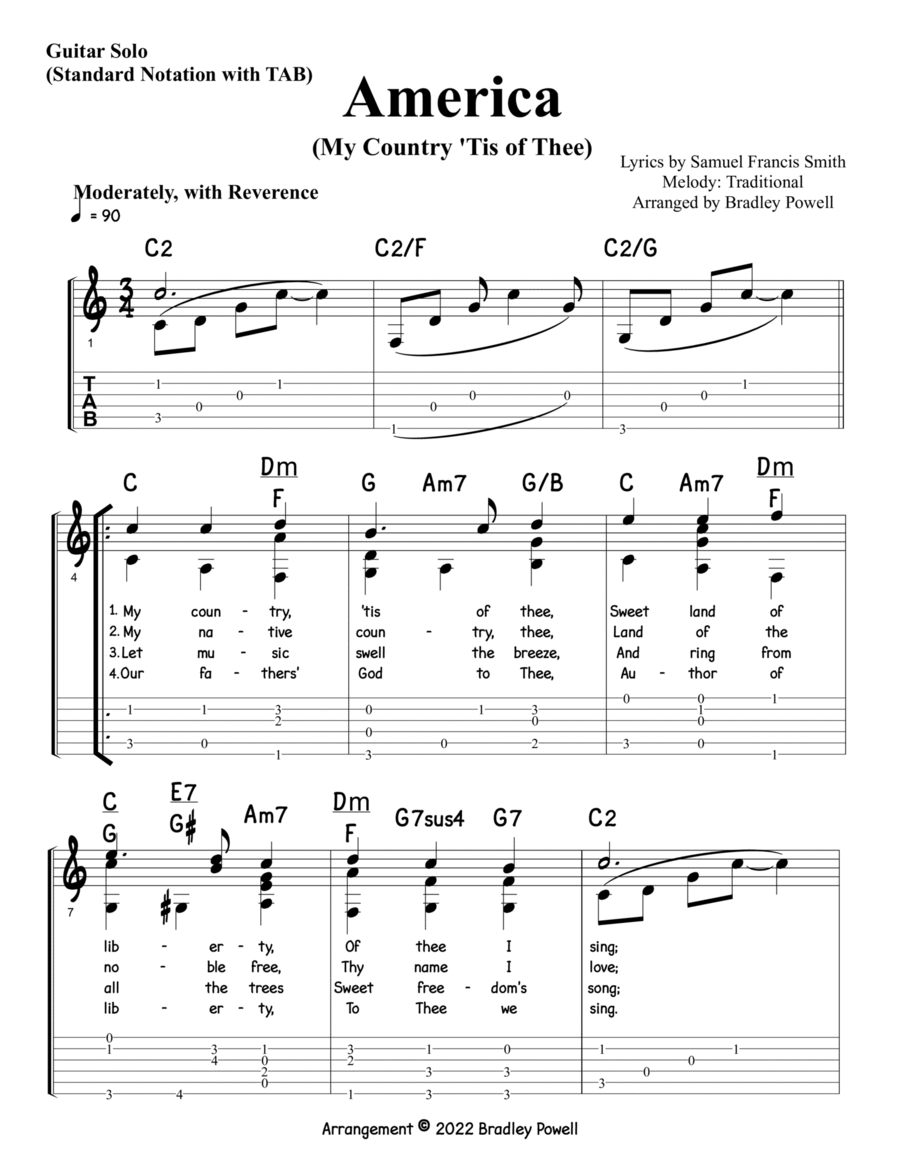Guitar,Voice - Level 2 - Digital Download SKU: A0.1042566 By The Candlelight Guitarist. By Words by Samuel Francis Smith, Music: traditional. Arranged by Bradley Powell. Patriotic,Sacred,Traditional. Guitar Tab with Voice. 2 pages. Geofonica Artistworks #647335. Published by Geofonica Artistworks (A0.1042566). Beloved American patriotic hymn arranged for Guitar solo, in both standard notation an TAB (instrumental finger-style, also suitable for accompanying singers, with lyrics included), arranged by Bradley Powell, who has recorded many albums as The Candlelight Guitarist. Level: beginning to Intermediate classical guitar, written in standard notation. (NOTE: This same arrangement in standard notation only, without TAB, is also available.) Arrangement features a short serene introduction, which serves as a transition motif within arrangement. Harmony is a subtle blend of traditional, folk-jazz and classical. Suitable for patriotic occasions, memorials, celebrations and religious services. ABOUT: Bradley Powell (aka The Candlelight Guitarist) began guitar at age ten, inspired by The Beatles. At 15, he became a protégé of jazz guitarist Joe Pass, and later studied classical guitar under Vincent Macaluso and at California State University, Northridge under Ronald Purcell, with a master class under Andrés Segovia. Brad was featured performing Gerald Wilson's Sonata for Guitar and Orchestra at the Hollywood Bowl, with the composer conducting. Brad was mentored in composition by David Rose (composer for Little House on the Prairie). Brad has composed music for TV, including Hill Street Blues and The 'A' Team, working with Mike Post. Brad has ten albums as The Candlelight Guitarist. Brad is also the classical guitarist for Disney's Princess Breakfast Adventuire at Disneyland's Grand Californian Resort. When not making music, Brad is often out hiking with his dogs.COMMENTS FROM ESTABLISHED REVIEWERS...Dr. Beth - Amazon.com #1 Hall of Fame reviewerBrad has a knack for putting together gentle, soothing guitar medleys which provide the perfect background or relaxation soundtrack.Bill Binkelman - Music Reviewer for Zone Music Reporter and New Age RetailerThe Candlelight Guitarist is your tour guide to a land of easy-going, warm, and inviting instrumentals.Rebecca of Amazon - Amazon.com HALL OF FAME TOP 500 REVIEWERBradley Powell's flawless playing allows you to completely relax into sleep or relax into an evening of candlelight and romance. I've fallen into a peaceful sleep while listening to this music and have also spent relaxing afternoons reading while The Candlelight Guitarist wove an intricate tapestry of sounds to nurture my heart. ... Bradley Powell's music is infused with natural ambience. As rich sounds renew your spirit, you can relax into a deep sigh of the heart. His style is artistic, heart healing and filled with romantic and cultural influences.Vicki Blizzard (Editor, PaperWorks and Crazy for Cross-Stitch! magazines) in CREATIVITY e-Letter: Music to filter into my dreams. My new favorite to listen to is classical guitar music by Bradley Powell.Jana L. Perskie Ceruleana (New York, NY USA) ~ Amazon.com TOP 50 Reviewer.The talented and creative Bradley Powell is the Candlelight Guitarist. His music is original and some of the most soul soothing I have ever heard.Bob McKillop, founder and publisher, MaineFolkMusic.comBrad Powell is a talented and highly trained California guitarist and composer who calls himself The Candlelight Guitarist, and for good reason. His music is perfect for situations in which candlelight figures prominently. Quiet meditation, romance, intellectual stimulation â the soft, pure tones of his Spanish and classic instrumental style open up your heart and render it more receptive to the spiritual messages that these pursuits engender.Grady Harp - HALL OF FAME TOP 100 REVIEWERmusic to soothe and calm and enrich the psyche. Would that there were more Brad Powells out there to help us all through these times. The world would be a saner place!
